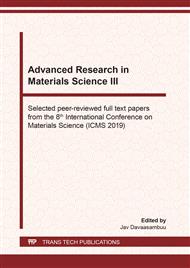[1]
Zhang A. G., Wang Y. J., Han X. F., and Zhang W. S. The effect of Pd doped in Ru layer on the interlayer coupling in Co/RuPd multilayers, Chin. Phys. 2004; 13: 2153.
DOI: 10.1088/1009-1963/13/12/031
Google Scholar
[2]
Pietrzak R., Szatanik R., Szuszkiewicz M. Investigation of diffusion and electromigration of hydrogen in palladium and PdAg alloy. J. Alloys Compd [J], 1999, 282: 130.
DOI: 10.1016/s0925-8388(98)00694-x
Google Scholar
[3]
Piotr Z., Ewa M. Diffusion coefficient of hydrogen in α-phase palladium and palladium-platinum alloy. Phys. Chem [J], 2001, 3: 2935.
DOI: 10.1039/b102114l
Google Scholar
[4]
Worsham J. E., Wilkinson M. K., Shull C. G. Neitron-Diffraction Observations on the Palladium-hydrogen and Palladium-deuterium systems. J. Phys. Chem. Solid [J], 1957, 3: 303.
DOI: 10.1016/0022-3697(57)90033-1
Google Scholar
[5]
Chan C. T., and Louie S.G. Self-consistent pseudo potential calculation of the electronic structure of PdH and Pd4H, Phys. Rev. B. 1983; 27: 3325.
Google Scholar
[6]
D. Tomanek, Z. Sun, S. G. Louie. Ab initio calculation of chemisorptions systems: H on Pd (001) and Pd(110). Phys. Rev. B [J], 1991, 43(6): 4699.
DOI: 10.1103/physrevb.43.4699
Google Scholar
[7]
C. Elsasser, M. Fahnle, L. Schimmele. Range of forces on host-metal atoms around interstitial hydrogen in Pd and Nb. Phys Rev B [J], 1994, 50: 5155.
DOI: 10.1103/physrevb.50.5155
Google Scholar
[8]
Y. Wang, S. N. Sun, M. Y. Chou. Total-energy study of hydrogen ordering in PdHx(0<x<1). Phys. Rev. B [J], 1996, 53: 1-4.
Google Scholar
[9]
Cui X., Wang J. T., Liang X. X., and Zhao G. Z. Ab initio studies on the structural and magnetic properties of RhH, Solid State Commun. 2009; 149: 322.
DOI: 10.1016/j.ssc.2008.11.031
Google Scholar
[10]
Cui X., Liang X. X, Wang J. T., and Zhao G. Z. Ab initio studies on the mechanic and magnetic properties of PdHx, Chin. Phys. B 2011; 20: 026201.
Google Scholar
[11]
Sarantuya N., Cui X., Wang Z. P. First-principles study of hydrogen diffusion in transition metal palladium, Modern Phys. Lett. B 2015; 29:1550064.
DOI: 10.1142/s0217984915500645
Google Scholar
[12]
Monkhorst H. J., and Pack J. D. Special points for Brillouin-zone integrations, Phys. Rev. B.1976; 13: 5188.
DOI: 10.1103/physrevb.13.5188
Google Scholar
[13]
Perdew J. P., Burke K., and Ernzerhof M. Generalized Gradient Approximation Made Simple, Phys. Rev. Lett. 1996; 77: 3865.
DOI: 10.1103/physrevlett.77.3865
Google Scholar
[14]
Mulliken R S. Electronic Population Analysis on LCAO–MO Molecular Wave Functions. II. Overlap Populations, Bond Orders, and Covalent Bond Energies, J. Chem. Phys.1955; 23: 1841.
DOI: 10.1063/1.1740589
Google Scholar
[15]
Houari A., Matar S. F., Eyert V. Electronic structure and crystal phase stability of palladium hydrides, J. Appl. Phys. 2014; 116: 173706.
DOI: 10.1063/1.4901004
Google Scholar
[16]
Mehl M. J., and Papaconstantopouls D. A. Applications of a tight-binding total-energy method for transition and noble metals: Elastic constants, vacancies, and surfaces of monatomic metals, Phys.Rev. B.1996; 54:4519.
DOI: 10.1103/physrevb.54.4519
Google Scholar
[17]
Korling M., and Haglund J. Cohesive and electronic properties of transition metals: The generalized gradient approximation, Phys. Rev. B.1992; 45: 13293.
DOI: 10.1103/physrevb.45.13293
Google Scholar
[18]
Sigals M., Papaconcontantopoulos D. A., and Bavalis N. C. Total energy and band structure of the 3d, 4d, and 5d metals, Phys.Rev.B.1992; 45:5777.
Google Scholar
[19]
Tomanek D., Sun Z., and Steven G. L. Ab initio calculation of chemisorption systems: H on Pd (001) and Pd (110), Phys. Rev. B. 1991; 43:4699.
DOI: 10.1103/physrevb.43.4699
Google Scholar


